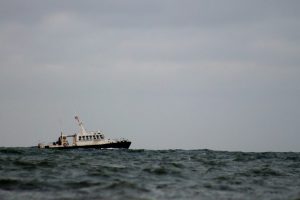In honor of Father Damien’s beatification on October 11, we revisit a story from 2000 about Molokai. The church continues to care for the settlements remaining residence today.
Is Kalaupapa the world’s most isolated spot? That’s what Hawaii’s King Kamehameha V thought in 1865, when he signed a law banishing people with advanced stages of leprosy (now called Hansen’s Disease) to the north shore of the island of Molokai.
Rough seas and 2,000-foot cliffs still keep the Kalaupapa peninsula fairly isolated today, although the remote place has acquired some name recognition, thanks to the courageous young priest who volunteered to go minister to this “leper colony” more than 100 years ago. The Belgian priest Father Damien De Veuster was declared blessed by the church in 1995.
What few people realize, however, is that Father Damien’s work continues in the 21st century. Three Franciscan sisters—Frances Therese Souza, Dativa Padilla, and Richard Marie Toal—tend the remaining 44 patients who live at Kalaupapa today, ministering to their physical, emotional, and spiritual needs.
The settlement on the peninsula appears much as any peaceful suburban community, except that two vehicles on a road constitute heavy traffic and there are no children. Wind, lapping waves, birdcalls, and the barking of a dog are the only sounds. Food, supplies, and visitors are flown in on small planes from Molokai and Honolulu, depending on the winds. Larger items like refrigerators and cars come once a year by barge. Otherwise, the steep trail on the cliffs is navigable only by mules or on foot.
The youngest patient at Kalaupapa was born in 1941. In 1969, Hawaii’s century-old isolation laws were abolished. Those who have chosen to remain do so for a variety of reasons, including persistent public ignorance about the disease and an insensitivity to their feelings. Everyone can come and go at will, as many did to Father Damien’s native Belgium for his beatification ceremony in 1995.
Today, most people who suffer from Hansen’s Disease are treated as outpatients with sulphone drugs, which became available in 1947. But the disease remains a public health problem in 24 countries, and it is estimated by the World Health Organization that about 2.5 million new patients will be diagnosed between 2000 and 2005. Over the past 15 years, 10 million leprosy patients have been cured; deformities preceding this treatment, however, cannot be reversed. The drugs are administered orally or by injection, but patients must be monitored by trained personnel because complications can occur.
That’s where the three sisters, who are all registered nurses, come in. During their 12-hour hospital rotations, they care for patients with the assistance of nurses from the Hawaii Department of Health and a visiting doctor, dentist, ophthalmologist, and orthopedic specialist who make regular visits to the settlement.
Hansen’s Disease is not the only affliction the sisters treat. As in any community, there is the gamut of “ordinary” medical challenges, such as heart and kidney disease, respiratory and circulatory problems, diabetes, cuts and scrapes, shingles, toothaches, and “everything but births.”
“In 20 years here, I have never been bored,” says Padilla.
The sisters also handle administrative paperwork and reports, vehicle maintenance, gardening, craft projects, and—with Father Joseph Hendricks—provide spiritual support to the community.
Toal, who served for 37 years in Kalaupapa, chose to remain there in her retirement. “I wanted to be here from the time I was in eighth grade,” she says.
The sisters draw inspiration from the stories of those who have gone before them in this ministry, including Father Damien and Mother Marianne Cope, who led the first sister-nurses to the island and to whom Father Damien entrusted his work after his death.
Father Damien’s hagiography contains stories about his compassion toward the sick and suffering people he eventually came to call “my fellow lepers.” It is said that he never hesitated to dress their wounds, share their meals, or bury them. This in a time when the afflicted were considered “unclean” and “outcasts.”
Mother Marianne shunned publicity and thus is not as well known as Father Damien, whose own leprosy brought him prominence whether he wanted it or not. The former provincial of the Sisters of the Third Order of St. Francis of Syracuse, New York, she had already founded Maui’s first hospital and a hospital for victims of leprosy near Honolulu when she responded to Father Damien’s plea for help.
On Kalaupapa, she started a home for homeless women and children and worked beside Father Damien until his death in 1889. An older patient remembers her as “strict but kind.” She was also known for her regime of dignity, order, and cleanliness, requiring handwashing between treatment of patients, which did much to lessen contagion. She predicted that no sister would contract leprosy at Kalaupapa, and none ever has.
Mother Marianne’s presence is still felt at Bishop Home, where the sisters live surrounded by portraits of her in several rooms. Padilla says, “Mother helps me do my work” and credits Mother Marianne with helping her to heal after recent surgery, “to continue the work.”
Death is a constant part of life at Kalaupapa; the area of graves is nearly as large as that of residences. A man points to the cemetery and explains, “These are my friends, this is my uncle, this is my cousin…” His use of the present tense suggests that his friends, uncle, cousin, and others are still with him, still part of the community.
When the last patient has died or left voluntarily, Kalaupapa will become a national historical park administered by the National Parks Service, which plans to maintain it both as a nature preserve and as a monument to the ability to conquer, both physically and spiritually, not only leprosy but the stigma and rejection that accompanied this insidious disease.
This article appeared in the June 2000 issue of U.S. Catholic.












Add comment